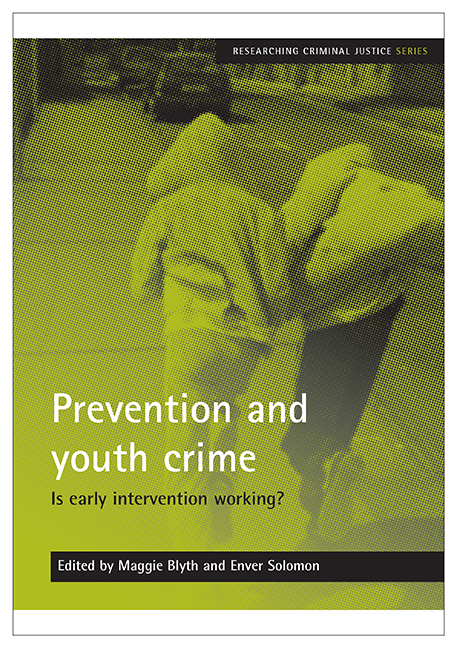Book contents
- Frontmatter
- Contents
- Foreword
- Acknowledgements
- List of abbreviations
- Notes on contributors
- Introduction
- 1 Integrated or targeted youth support services: an essay on ‘prevention’
- 2 Intervening in gang-affected neighbourhoods
- 3 Family intervention projects and the efficacy of parenting interventions
- 4 Early intervention and prevention: lessons from the Sure Start programme
- 5 Attachment research and the origins of violence: a story of damaged brains and damaged minds
- 6 Early intervention in the youth justice sphere: a knowledge-based critique
- 7 European perspectives on prevention
- Conclusion
4 - Early intervention and prevention: lessons from the Sure Start programme
Published online by Cambridge University Press: 25 March 2023
- Frontmatter
- Contents
- Foreword
- Acknowledgements
- List of abbreviations
- Notes on contributors
- Introduction
- 1 Integrated or targeted youth support services: an essay on ‘prevention’
- 2 Intervening in gang-affected neighbourhoods
- 3 Family intervention projects and the efficacy of parenting interventions
- 4 Early intervention and prevention: lessons from the Sure Start programme
- 5 Attachment research and the origins of violence: a story of damaged brains and damaged minds
- 6 Early intervention in the youth justice sphere: a knowledge-based critique
- 7 European perspectives on prevention
- Conclusion
Summary
Introduction
The concept of social exclusion has been central to New Labour's social policy since its election in 1997. Shortly after its election success, the government announced the setting up of the Social Exclusion Unit, located in the Cabinet Office, working with the Number 10 Policy Unit and reporting to the Prime Minister (Levitas, 2005, p 147). The unit was staffed by co-opted members from the civil service, the police, the voluntary sector and business, and involved government ministers from across a range of government departments, reflecting the way in which social exclusion was understood as involving multiple causes and resulting in a range of social problems.
An important feature of the conceptualisation of social exclusion is its intergenerational reproduction: longitudinal social surveys indicate that children born to parents who are socially excluded are themselves at much greater risk of being socially excluded themselves as they grow up (Welshman, 2007). This has resulted in a central place being given to policies that aim to intervene to prevent it. Seeing the process of social exclusion in terms of a cycle of disadvantage or of deprivation has in turn resulted in a focus on the significance of early childhood experience and an unprecedented expansion of policies and services directed at preschool children and their parents. The Sure Start programme, announced in 1998 and expanded by 2004 to include 400,000 children under four and their families, has been a central element in the government's long-term strategy to prevent social exclusion by breaking the cycle that plays a significant part in its (re)production. This chapter looks at how the problem of the intergenerational reproduction of social exclusion has been conceptualised by the New Labour governments and how this is reflected in policy. It examines the evolving policy interventions since 1997 with parents of preschool children designed to ‘break the cycle’, and what this conceptualisation of social exclusion and the policies associated with it leave out.
Social exclusion and its reproduction
The concept of social exclusion is a complex one, with numerous overlapping definitions. A report by Ruth Levitas and colleagues at the University of Bristol for the Social Exclusion Unit identified 12 different definitions of social exclusion/inclusion in use by different government departments, by academics and within the European Union. These definitions operate at different levels, are normative to different extents and are operationalised using a variety of different indicators.
- Type
- Chapter
- Information
- Prevention and Youth CrimeIs Early Intervention Working?, pp. 53 - 68Publisher: Bristol University PressPrint publication year: 2008



